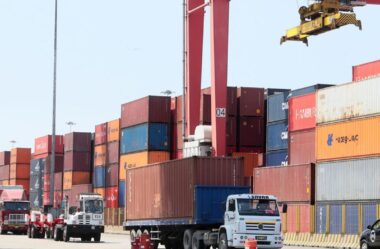Tempo de leitura: 8 minutos
Peru closed last week with positive news for its economy: Elizabeth Galdo, the Minister of Foreign Trade and Tourism, announced that during the first quarter of 2024, the Andean country’s Special Economic Zones (ZEE) totaled US$ 18.3 million in exports. There was a notable participation of the Economic Development Zones of Paita (91%), Tacna (6%) and Matarani (3%).
Galdo highlighted as an achievement that the Peruvian SEZs have shown an annual increase of 3% in the value of their exports, highlighting sectors such as agriculture (61%) and chemicals (30%). In addition, these regions, which have special economic regulations with the aim of attracting foreign investment and promoting job creation, have managed to position processed goods such as beverages, snacks , chemical additives, metal tools, among others.
However, these are modest advances compared to the potential of this model shown in other Latin American countries. A report by the Association of Free Trade Zones of the Americas indicates that in 2020, SEZs contributed 7.9% to the GDP of Costa Rica, 6.4% in the Dominican Republic and 4.8% in Uruguay. Meanwhile, Peru did not even reach 1%, a deficiency that is more evident when comparing the fact that the country only has four free trade zones currently, compared to the hundred that Colombia has.
The discussion on the viability of SEZs in Peru took on new importance on July 30, when President Dina Boluarte announced that her government was working on the regulatory framework for a SEZ located between the port of El Callao and the new megaport of Chancay.
The president explained that the project seeks to facilitate and offer better conditions to attract investments in high-tech industries, as well as to promote employment and technological innovation. In turn, it was promised that the necessary infrastructure would be built to integrate the SEZ with the Panamericana Norte and the Peruvian mountain railway network. Given the expectations, it is worth asking what the chances of success are for an SEZ, which is preceded by discrete initiatives.
“Special Economic Zones in Peru have only been seen under a purely tax-based approach. That is what research shows and the main criticisms in this regard. Because when one accesses a SEZ, the general idea is that you have some tax benefits such as reducing income tax. But the main criticism is that there is no central objective towards which resources these economic zones should focus,” declared Juan Carlos Ladines, economist and professor at the Universidad del Pacífico (Peru) for AméricaEconomía .
In his view, Ladines argues that the four active SEZs in Peru (Paita, Matarani, Ilo and Tacna), although located in strategic coastal locations, do not specialize in the shipping or production of any particular type of goods. The economist criticizes the fact that the political discussion ignores urgent measures such as an export promotion policy that defines whether a SEZ will be oriented toward agricultural exports, the textile industry or logistics.
On the other hand, a Comex Peru report, prepared in September 2023, points out that the lack of adequate infrastructure and qualified labor has hindered the development of SEZs. In fact, although Moquegua, Tacna and Arequipa, departments in southern Peru where three SEZs are located, have improved their performance in the Regional Competitiveness Index, the absence of a major industry and suppliers hinders any possibility of development. This situation significantly reduces the incentive to attract exports or investments, which also generates fewer jobs.
“Peru has not managed to insert itself into the large global value chains. So it has missed many opportunities to face globalization and also the reconfiguration that is taking place in the world economy due to the trade war between the United States and China. The pandemic already caused a rupture in the logistics chain and there was a shortage, because initially there were not enough ships to transport goods,” said Roberto de la Tore, president of the Lima Chamber of Commerce for AméricaEconomía .
De La Tore points out that this crisis has caused the two world superpowers to bet heavily on nearshoring , in other words, the relocation of supply chains. This is a policy that has gained momentum in countries such as Mexico and Brazil, where foreign companies manufacture everything from electric vehicles to lithium batteries.
We are talking about a great business opportunity that, already in 2022, the Inter-American Development Bank (IDB) established that nearshoring in the short and medium term would represent an increase of up to US$ 78 billion in new exports of goods and services. Given this potential, De La Tore points out that Peru could take advantage of this phenomenon in the SEZs to attract multinational companies and foreign direct investment that would impact the country’s economic development.
A notable example is the Dominican Republic, a Caribbean country, where according to AZFA, as of May 2024, there are some 820 local and foreign companies operating in its free trade zones. Exports exceeded US$ 8 billion in 2023 and each zone specializes in traditional goods such as textiles and tobacco, but also pharmaceutical products and medical equipment.
THE DEBATE IN THE PERUVIAN CONGRESS
However, the poor performance of the Peruvian SEZs could be in for a change of direction, as in recent months, the parliament has presented proposals to change the legal framework of this model. In May 2024, Eduardo Salhuana, then president of the Economic Commission of the Peruvian Congress, presented a bill that establishes a special tax and customs regime for the new free trade zones.
The first is that the management of the SEZs is in private hands. It should be noted that currently, the free zones operate with a board chaired by the Regional Government and made up of representatives of the municipality and the local Chamber of Commerce. This modality has earned numerous critics who accuse it of being very bureaucratic and therefore, inefficient to manage.
If the new model is approved by Congress, the private sector would now propose the location of the new SEZs and manage them, while the Peruvian State would only be limited to evaluating and approving the proposals, as well as the requirements and amounts of investment committed.
Likewise, Salhuana proposed a second measure that involves total exemption from income tax (IR), as occurs in the SEZs of the Dominican Republic, Costa Rica and Panama. Subsequently, the Peruvian Ministry of Economy and Finance proposed an IR rate higher than 15% and lower than 20%. Although Salhuana, currently president of the Peruvian Congress, promised to reach a consensus, the new legal framework for the SEZs is currently awaiting the final verdict.
“I believe that the current free trade zones have not developed due to the complexity of managing public areas, because they belong to the State. For example, the northern one (Paita) had problems with energy and drinking water supply. There are four that operate under these conditions and others that did not even function. But if they are changed to a private operator that already has experience in managing these zones, these investments can be received. Chancay could adopt this model to attract Chinese companies,” said Rafael Zacnich, manager of Economic Studies at COMEX Peru for AméricaEconomía .
However, Zacnich adds that not only should the new law create incentives for investment, but it should also impose regulations that reduce the risk of smuggling and force the operator to meet certain goals of technological investment and job creation for the local population.
On the other hand, the experts consulted agree that the Peruvian State has focused solely on the coast to open free trade zones. The fact that the country is located in the middle of South America and also has navigable rivers provides opportunities to open free trade zones in untapped regions such as the Amazon.
“River trade in Peru is completely underutilized. Cities like Iquitos that look out onto the Amazon River could be the starting point for transforming trade and following the example of Brazil, which has industrial hubs in different areas,” says Juan Carlos Ladines. A clear example is the city of Manaus, an Amazonian city that has had a free trade zone since 1967. By 2019, it provided more than 78,000 direct jobs and was home to 194 companies, most of which are dedicated to the manufacture of motorcycles and computer supplies.
“Colombia has more than 120 special economic zones, roughly 70% of its territory. The largest is Bogotá, which is inland. So, for a free trade zone you do need to have connectivity: access to roads, drinking water and energy, but that doesn’t mean that the model is restricted to a port or its surroundings,” says Roberto de la Tore.
Fonte: América Economia | Foto: Reprodução/América Economia







Os comentários foram encerrados, mas trackbacks e pingbacks estão abertos.